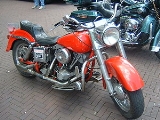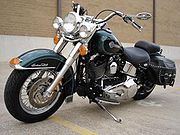
Harley-Davidson FL
Encyclopedia

Harley-Davidson
Harley-Davidson , often abbreviated H-D or Harley, is an American motorcycle manufacturer. Founded in Milwaukee, Wisconsin, during the first decade of the 20th century, it was one of two major American motorcycle manufacturers to survive the Great Depression...
from 1941 to present. Mostly applied to Harley's large-framed bikes, including the current Touring series, the FL designation is also used with their Softail
Softail
The term softail refers to motorcycles and bicycles that feature a rear suspension system with springs or shock absorbers to absorb bumps. On Softail motorcycles, the shock absorbers or springs are often hidden underneath out of view to give the appearance of a hard-tail or rigid frame, however...
series, especially on Softails with traditional styling, 16-inch front wheels, and either Springer forks or large-diameter telescopic front forks.
Early FL models
The FL was introduced to the Harley-Davidson model line in 1941. It used a 74 cubic inch version of the "KnuckleheadKnucklehead
The knucklehead was a Harley-Davidson motorcycle engine, so named because of the distinct shape of the rocker boxes. The engine is a two cylinder, 45 degree, pushrod actuated overhead valve V-twin engine with two valves per cylinder. It was the third basic type of V-Twin engine used by...
" OHV
Overhead valve
An overhead valve engine, also informally called pushrod engine or I-head engine, is a type of piston engine that places the camshaft within the cylinder block , and uses pushrods or rods to actuate rocker arms above the cylinder...
engine that powered the EL in 61 cubic inch form. The FL shared its frame with the EL and with the U and UL, which used a 74 cubic inch flathead engine. The FL replaced the UH and ULH, which used the same frame with 80 cubic inch flathead engines.
The FL continued relatively unchanged until 1948, when it and the EL were given redesigned "Panhead
Panhead
The panhead was a Harley-Davidson motorcycle engine, so nicknamed because of the distinct shape of the rocker covers. The engine is a two-cylinder, two-valve-per-cylinder, pushrod V-twin...
" engines of the same capacities as before. These engines had several improvements over the earlier "Knuckleheads", including aluminum cylinder heads to reduce weight and improve cooling and self-adjusting hydraulic lifters. The U and UL flathead twins were discontinued in 1948, leaving the OHV EL and FL models as Harley-Davidson's large-frame motorcycles.
Hydra-Glide
In 1949, a year after receiving the "Panhead" engine, the FL was given a new front suspension and a model name to go along with it. In honor of their first production motorcycle with hydraulically damped telescopic forks, the FL was officially called the Hydra-Glide. This name would change twice in the history of the basic large-framed FL bikes, each time signalling an improvement in the bike's technology. In addition, the Glide ending would be used on other models, based on both and FL and FX formats.In 1952, the Hydra-Glide's transmission standard hand-shift/foot-clutch was joined by the optional foot-shift/hand-clutch. Although the original format continued to be offered as an option until 1978. 1952 was also the last year of the 61 cubic inch EL, making the FL the last remaining large-frame model.
Although the 1903 founding is now the basis for "Anniversary Models", Harley-Davidson's 50th Golden Anniversary was celebrated in 1954 with special paints and badges on the front fender. (1904 was the first year of production.)
A more highly tuned engine with high-compression heads, higher-lift cams, and polished ports, was offered with the FLH version of 1955. The FLH designation has continued up to the present.
Duo-Glide

Unlike OHV configuration, aluminum heads, and telescopic-fork front suspension, however, this improvement in technology was applied to the small-frame bikes first, the K-series having received rear suspension in 1952.
Electra Glide

Harley-Davidson Servi-Car
The Harley-Davidson Servi-Car was a three-wheeled utility motorcycle manufactured by Harley-Davidson from 1932 to 1973.-Concept and uses:The Servi-Car was designed during the Great Depression when Harley-Davidson was desperate to expand its product base to increase sales...
having received electric start the year before. This innovation for Harley-Davidson was greeted with the new model name of Electra Glide.
In 1966, the "Panhead" gave way to the "Shovelhead
Shovelhead engine
The Shovelhead is an air-cooled, 45 degree, V-twin motorcycle engine manufactured from 1966 to 1984 by the Harley Davidson Motor Company. It has of displacement and, after 1978, was increased to for Harley's Big Twin bikes....
", gaining a ten percent increase in power in the process.
A fork-mounted fairing
Motorcycle fairing
A motorcycle fairing is a shell placed over the frame of some motorcycles, especially racing motorcycles and sport bikes, with the primary purpose to reduce air drag. The secondary functions are the protection of the rider from airborne hazards and wind-induced hypothermia and of the engine...
became available on Electra Glides in 1969. This became unofficially known as the "batwing" fairing. Although the batwing fairing was an easily removable option on early Electra Glides, it was not removable on later machines, as the instruments were moved from the fuel tank into the fairing.

The FL was given a front disc brake in 1972.
The three-speed plus reverse option was discontinued in 1977.
An 80 cubic inch engine was made optional on the Electra Glide in 1978. However, the FL designation was not changed as a result. By 1981, the 80 cubic inch engine was the standard engine; the 74 cubic inch engine being discontinued.
The low-compression FL engine was discontinued in 1979, as was the option for hand-shift/foot-clutch transmission controls.
Tour Glide
The FLT Tour Glide was introduced in 1979. Sold alongside the existing FLH Electra Glide, the FLT had a larger frame with rubber engine mounts, a five-speed transmission, the 80 cubic inch engine, and a frame-mounted fairing. In order that the FLT frame, which was larger and heavier than the large and heavy FLH frame, would handle acceptably, the front forks were given radical steering geometry which had them mounted behind the steering head, with the frame behind the steering head being recessed to allow adequate steering lock.The FLHT was introduced in 1983. This was an Electra Glide based on the FLT Tour Glide frame, but using the Electra Glide "batwing" fairing instead of the Tour Glide frame-mounted fairing.
Except for the base FLH, all 1984 FLs were equipped with the new rubber-mounted Evolution engine and a five-speed transmission.
All "Shovelhead" engines were discontinued by the 1985 model year. In that year, the four-speed solid-engine-mount FLH was modified to accept rubber mounting and the Evolution engine. The FLH was discontinued in 1986; all Touring models thereafter used the FLT/FLHT frame. Ironically, the FLT Tour Glide, which introduced the current Touring frame, was dropped from the lineup in 1996. The frame-mounted Tour fairing would return with the FLTR Road Glide in 1998.
The Evolution engine
Evolution engine
The Evolution engine is an air-cooled, 45-degree, V-twin engine manufactured since 1984 by the Harley Davidson Motor Company for the company's motorcycles. It was made in the displacement for Harley Davidson Big V-twins bikes, replacing the Shovelhead engine, until 1999 when it was replaced by...
was replaced by the Twin Cam 88 engine
Twin Cam engine (Harley-Davidson)
The Harley-Davidson Twin Cam 88 engine was released for the 1999 model year in September 1998. The Twin Cam 96 was released for the 2007 model year. Although these engines were the successors to the Evolution engine , they share a number of characteristics with nearly all previous Harley-Davidson...
on all large-frame Harley-Davidson motorcycles in 1999.
Unfaired Glides

2009 Touring chassis
For the 2009 model year, Harley-Davidson redesigned the entire touring range. The changes included a new frame, new swingarm, a completely revised engine-mounting system, 17-inch front wheels for all models except the Road King Classic, a 6 gallons (22.7 l) fuel tank, and a 2-1-2 exhaust. The changes result in greater load carrying capacity, better handling, a smoother engine, longer range and less exhaust heat transmitted to the rider and passenger.Tri-Glide Ultra Classic
Also released in the FL Touring range for the 2009 model year was the FLHTCUTG Tri Glide Ultra Classic, the first three-wheeled Harley-Davidson since the Servi-CarHarley-Davidson Servi-Car
The Harley-Davidson Servi-Car was a three-wheeled utility motorcycle manufactured by Harley-Davidson from 1932 to 1973.-Concept and uses:The Servi-Car was designed during the Great Depression when Harley-Davidson was desperate to expand its product base to increase sales...
was discontinued in 1973. This model features a unique frame and a 103 cid engine exclusive to the trike.
FL Softails

Harley-Davidson introduced the Softail
Softail
The term softail refers to motorcycles and bicycles that feature a rear suspension system with springs or shock absorbers to absorb bumps. On Softail motorcycles, the shock absorbers or springs are often hidden underneath out of view to give the appearance of a hard-tail or rigid frame, however...
chassis in 1984. The original Softails used the small FX telescopic forks, but the FLST Heritage Softail with large FL telescopic forks was introduced in 1986. The FLSTC Heritage Softail Classic, with large front forks and retro styling, was in production by 1988.
Other Softails with big forks followed, including the 1990 introduction of the FLSTF Fat Boy and the 1993-only FLSTN "Cow Glide". The base FLST Heritage Special was discontinued in 1991. The FLSTN was continued after 1993 without the bovine motif as the Nostalgia model until 1997, when it was replaced by the FLSTSC Springer Classic. The Springer Classic is also designated as an FL despite using Springer forks instead of the large FL telescopic forks.
In 2000, all Softails, including the FL models, were switched from the Evolution engine
Evolution engine
The Evolution engine is an air-cooled, 45-degree, V-twin engine manufactured since 1984 by the Harley Davidson Motor Company for the company's motorcycles. It was made in the displacement for Harley Davidson Big V-twins bikes, replacing the Shovelhead engine, until 1999 when it was replaced by...
to the counterbalanced Twin Cam 88B engine
Twin Cam engine (Harley-Davidson)
The Harley-Davidson Twin Cam 88 engine was released for the 1999 model year in September 1998. The Twin Cam 96 was released for the 2007 model year. Although these engines were the successors to the Evolution engine , they share a number of characteristics with nearly all previous Harley-Davidson...
specially developed for the rigid engine mounting in this frame.
The FLSTN designation returned in 2005 with the Softail Deluxe.
The FLSTN Deluxe, which was introduced in 2005, also came with an option of carb or EFI models. The year 2005 was also the last in which a carb was offered on all HD models.

